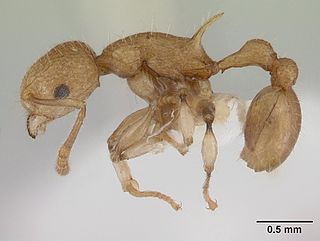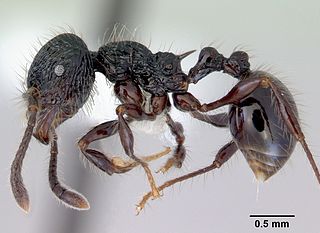
Myrmicinae is a subfamily of ants, with about 140 extant genera; their distribution is cosmopolitan. The pupae lack cocoons. Some species retain a functional sting. The petioles of Myrmicinae consist of two nodes. The nests are permanent and in soil, rotting wood, under stones, or in trees.

Harpagoxenus is a genus of ants in the subfamily Myrmicinae. Found in the Palaearctic and Nearctic ecozones of the world, Harpagoxenus was first established as Tomognathus by Mayr (1861) to house the species Myrmica sublaevis. However, the name had already been used (homonym) for a genus of fish, and was replaced with its current name by Forel (1893).

Strongylognathus is a genus of ants in the subfamily Myrmicinae. Many of its species are endemic to specific regions.

Crematogastrini is a tribe of myrmicine ants with 64 genera and 8 fossil genera.

Ponera is a genus of ponerine ants. The name is the Latinized form of the Ancient Greek ponira.

Cryptopone is a genus of ants in the subfamily Ponerinae. The genus has a worldwide distribution, with most species occurring in Asia. Workers range from very small to medium in size (1.7–6.1 mm), with the queens being slightly larger.

Myopias is a genus of ants in the subfamily Ponerinae. The genus is known from the Oriental, Indo-Australian, and Australasian regions.

Myopopone is a genus of ants in the subfamily Amblyoponinae. The genus contains two species, one extant and one fossil. The type species Myopopone castanea is known from the Oriental and Indo-Australian regions, and China. The fossil species, Myopopone sinensis, is known from the Early Miocene.

Proceratium is a rare genus of ants in the subfamily Proceratiinae. It is the type genus of the tribe Proceratiini, which in addition to Proceratium consists of two even rarer genera: the extant Discothyrea and the fossil genus Bradoponera.

Discothyrea is a genus of small ants in the subfamily Proceratiinae. The genus is distributed in the tropics and subtropics throughout the world, where they usually nest in rotten wood, in the leaf litter, or under stones. Little is known about their biology, but ants in this genus are thought to be specialist predators of arthropod eggs and have been observed storing eggs in their nests.

Vombisidris is a genus of subarboreal and arboreal ants in the subfamily Myrmicinae. Its species are known from India to Queensland, Australia. Like most other arboreal ants, their biology remains unknown.

Rotastruma is a small genus of arboreal ants in the subfamily Myrmicinae. Its two species are known from the Oriental region: the type species Rotastruma recava is known from the Bukit Timah Nature Reserve, Singapore, and Rotastruma stenoceps is known from Guangdong, China.
Gaoligongidris is an Asian genus of ants in the subfamily Myrmicinae. It contains the single species Gaoligongidris planodorsa, collected in the Gaoligong Mountains, Yunnan Province, China. The genus is known only from workers and nests in the soil, and forages on the ground. While similar to the genus Lophomyrmex of the tribe Attini, Gaoligongidris is most closely related to the Indo-Australian Lasiomyrma, tribe Crematogastrini.

Carebara is a genus of ants in the subfamily Myrmicinae. It is one of the largest myrmicine genera with more than 200 species distributed worldwide in the tropics and the Afrotropical region. Many of them are very tiny cryptic soil and leaf-litter inhabitants. They nest in rotten wood to which the bark is still adherent in the Afrotropical region, or may be lestobiotic nesting near other ant species. Some species are known to exist parasitically within termite nests. Little is known about the biology of the genus, but they are notable for the vast difference in size between queens and workers.

Recurvidris is a genus of ants in the subfamily Myrmicinae. The genus is distributed in the Indomalayan realm, where the ants are found on the forest floor.

Perissomyrmex is a genus of ants in the subfamily Myrmicinae. It is known from the Neotropical and Oriental realms.

Paratopula is a genus of ants in the subfamily Myrmicinae. The genus consists of arboreal species known from the Oriental and Indo-Australian regions. Little is known about their biology.

Emeryopone is a small genus of ants in the subfamily Ponerinae. The genus is distributed in Asia, from Israel to Indonesia. Little is known about their biology, and males remain unknown.

Yunodorylus is a genus of ants in the subfamily Dorylinae containing four described species. The genus is distributed widely across mainland Southeast Asia and the island of Borneo. Yunodorylus was described in 2000, later placed as a junior synonym of Cerapachys by Bolton (2003), and was resurrected as a valid genus by Borowiec (2016)


















